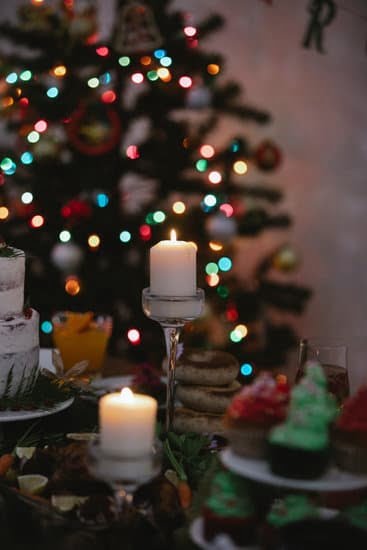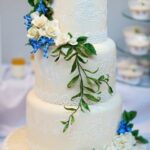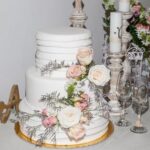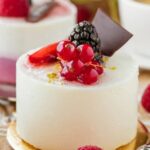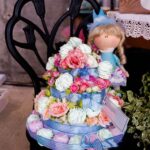Are you interested in learning how to be a cake decorator? Whether it’s for personal enjoyment or as a potential career path, this article will provide you with the essential information to get started in the world of cake decorating. From understanding the basic tools and techniques to turning your hobby into a successful business, we’ve got you covered.
Cake decorating is a creative and rewarding skill that allows you to express your artistic talents while making delicious treats. The possibilities are endless when it comes to designing beautiful and unique cakes, making it an exciting endeavor for anyone with a passion for baking and artistry.
In this section, we will introduce you to the fundamentals of cake decorating, including the essential tools and equipment needed to get started, basic techniques for beginners, tips on choosing the right type of icing and frosting, as well as the importance of color theory in creating stunning designs. Whether you’re a novice or looking to enhance your existing skills, this guide will walk you through everything you need to know about becoming a cake decorator.
The Essential Tools and Equipment Needed to Get Started
When starting out as a cake decorator, having the right tools and equipment is essential to creating beautiful and professional-looking cakes. Here are some of the basic items you’ll need to get started in your cake decorating journey:
Cake Pans
Having a variety of cake pans in different shapes and sizes is crucial for creating different designs and styles of cakes. Invest in high-quality pans that will help you achieve even baking and easy release of the cakes.
Piping Bags and Tips
Piping bags and tips are essential for decorating cakes with frosting, buttercream, or royal icing. Different tips create different designs, so it’s important to have a variety of them in your collection.
Offset Spatula
An offset spatula is a must-have tool for smoothing and spreading frosting on the cake layers. It allows for precise control and helps create a professional finish.
Turntable
A turntable makes it easier to frost and decorate the sides of a cake by allowing you to smoothly rotate the cake as you work on it.
Fondant Tools
If you plan on working with fondant, investing in fondant tools such as rolling pins, smoothers, cutters, and sculpting tools is essential for creating intricate designs.
By having these essential tools and equipment on hand, you’ll be well-equipped to start learning how to be a cake decorator and begin creating stunning cakes for any occasion. Whether it’s birthdays, weddings, or other special events, having the right equipment is crucial in making your creations stand out.
Basic Cake Decorating Techniques for Beginners
For those just starting out in the world of cake decorating, mastering some basic techniques is essential. One of the first things to learn is how to properly fill and ice a cake. This involves leveling the cake layers, spreading a layer of frosting between each layer, and then covering the entire cake with a smooth coat of frosting. It may take some practice to achieve a flawless finish, but with patience and the right tools, it can be accomplished.
Another important skill for beginners to develop is piping techniques. Piping allows decorators to create intricate designs and patterns on cakes using different types of tips and bags. Start by practicing basic piping techniques such as stars, shells, and rosettes before moving on to more complex designs.
Furthermore, fondant work is another area that beginners should familiarize themselves with. Working with fondant allows decorators to create sculpted figures, smooth coverings, and decorative accents for their cakes. Learning how to roll out fondant properly and apply it to a cake without tearing or wrinkling is a key skill.
As you begin your journey as a cake decorator, be sure to practice these basic techniques regularly. With time and dedication, you will improve your skills and be able to move on to more advanced decorating methods.
Tips on Choosing the Right Type of Icing and Frosting
When it comes to cake decorating, choosing the right type of icing and frosting is essential to achieve the perfect finish for your creation. There are several options available, each with its own unique texture and flavor profile. Understanding the different types of icing and frosting will help you make an informed decision based on the design and flavor of your cake.
Buttercream
Buttercream is a popular choice for cake decorating due to its smooth and creamy texture. It can be easily colored and flavored, making it versatile for various designs. This type of frosting is perfect for creating intricate piping designs, flowers, and borders on cakes.
Fondant
Fondant is a pliable sugar paste that can be rolled out into thin sheets to cover cakes or shaped into 3D decorations. It provides a smooth and flawless finish, making it ideal for wedding cakes or special occasion cakes. However, some people may find fondant too sweet, so it’s important to consider the taste preferences of your clients.
Cream Cheese Frosting
Cream cheese frosting is known for its tangy flavor and soft consistency. It pairs well with carrot cake, red velvet cake, and other dessert flavors. This type of frosting is best suited for casual or rustic cake designs.
Ultimately, the type of icing and frosting you choose will depend on the specific requirements of your cake design as well as the taste preferences of your clients. Experimenting with different types of icing and frostings will allow you to develop a good understanding of their properties and how they can be used to enhance your cake decorating skills.
Step-by-Step Guide to Creating Stunning Cake Designs
Do you want to learn how to be a cake decorator? One of the most exciting aspects of being a cake decorator is the opportunity to unleash your creativity and design stunning cakes that will impress everyone who sees them. Whether you’re a beginner or have some experience in cake decorating, it’s essential to understand the step-by-step process of creating beautiful and intricate cake designs.
To help you get started on your journey to becoming a skilled cake decorator, here is a step-by-step guide to creating stunning cake designs:
1. Plan your design: Before you start decorating your cake, it’s important to come up with a clear plan for the design. Consider the theme or occasion, color scheme, and any specific details you want to include.
2. Prepare your tools and materials: Gather all the necessary tools and materials for decorating, such as piping bags, tips, fondant, food coloring, edible decorations, etc.
3. Level and crumb coat the cake: Leveling your cake layers ensures a flat surface for decorating, while crumb coating helps seal in crumbs and provides a smooth base for icing or fondant.
4. Apply icing or fondant: Depending on the design you have planned, apply a layer of buttercream icing or rolled fondant to cover the entire cake.
5. Add decorative elements: Use piping techniques, sculpting tools, molds, stencils, or edible embellishments to create intricate designs on the cake’s surface.
6. Finishing touches: Finally, add any finishing touches or details to complete your stunning cake design.
By following these steps and practicing different techniques, you can develop your skills as a cake decorator and create visually captivating cakes for any occasion.
Looking for more tips on how to be a cake decorator? Explore our extensive resources below:
The Importance of Color Theory and How It Applies to Cake Decorating
Color theory plays a crucial role in the world of cake decorating, as it can greatly influence the overall look and appeal of a cake design. Understanding how different colors work together and their impact on emotions and perceptions can help decorators create stunning and visually appealing designs.
One key aspect of color theory in cake decorating is knowing how to combine different colors to create harmonious and balanced designs. By understanding color schemes such as complementary, analogous, or monochromatic, decorators can create visually pleasing cakes that draw attention and evoke certain emotions.
Furthermore, being familiar with color psychology can also be beneficial for cake decorators. Different colors have the power to convey specific moods or feelings, so knowing how to use them appropriately can help enhance the message or theme of a cake design.
Aspiring cake decorators should take the time to study and practice the principles of color theory in their designs. Experimenting with different color combinations, understanding the impact of light on colors, and learning how to use shading and highlighting techniques can all contribute to creating visually striking and memorable cakes that leave a lasting impression.
By incorporating the principles of color theory into their cake decorating skills, decorators can elevate their designs to new heights and captivate their audience with eye-catching creations that showcase their artistic talent.
How to Turn Your Cake Decorating Hobby Into a Successful Business
Turning your passion for cake decorating into a successful business can be a fulfilling and lucrative endeavor. Here are some key steps to help you transform your hobby into a successful cake decorating business:
- Develop a Unique Selling Point (USP): Consider what sets your cake decorating business apart from others. Whether it’s your signature designs, use of organic ingredients, or personalized customer service, having a USP will help you stand out in the market.
- Create a Business Plan: Outline your goals, target market, pricing strategy, and marketing approach. A well-thought-out business plan will guide you in the right direction and increase your chances of success.
- Build an Online Presence: In today’s digital age, having a strong online presence is crucial for any business. Create a professional website showcasing your portfolio, testimonials from satisfied clients, and information about your services.
Utilizing social media platforms such as Instagram and Facebook to showcase your creations can also help attract potential customers.
Offer Classes and Workshops
Share your knowledge and skills by offering cake decorating classes and workshops. This not only generates additional income but also establishes you as an expert in the field.
Network and Collaborate
Connect with local event planners, bakeries, and wedding venues to explore collaboration opportunities. Networking within the industry can lead to referrals and partnerships that can expand your client base.
By implementing these strategies, you can pave the way for turning your passion for cake decorating into a thriving business venture. With dedication, creativity, and excellent customer service, you can achieve success as a professional cake decorator.
Resources for Further Education and Training in Cake Decorating
If you are interested in becoming a professional cake decorator, there are several resources available to help you further your education and training in this field. Many culinary schools and community colleges offer courses specifically focused on cake decorating. These courses often cover advanced techniques, working with fondant, creating tiered cakes, and cake sculpting.
In addition to formal education programs, there are also many online resources available for aspiring cake decorators. Websites and blogs dedicated to cake decorating offer tutorials, tips, and inspiration for both beginners and experienced decorators. Online forums and social media groups provide opportunities to connect with other decorators, share ideas, and seek advice on various aspects of the craft.
Attending workshops or seminars led by professional cake decorators can also provide valuable hands-on experience and insight. These events often focus on specific skills or trends within the industry, giving participants the opportunity to learn from experts and expand their knowledge. Ultimately, pursuing further education and training in cake decorating can help individuals refine their skills and stay up-to-date with the latest techniques and trends in the field.
| Resource | Description |
|---|---|
| Culinary school courses | Formal education programs that cover advanced techniques such as working with fondant and creating tiered cakes. |
| Online resources | Websites, blogs, forums, and social media groups providing tutorials, tips, inspiration, and opportunities to connect with other decorators. |
| Workshops/seminars | Events led by professional decorators offering valuable hands-on experience focused on specific skills or industry trends. |
The Dos and Don’ts of Cake Decorating
Cake decorating is a skill that requires practice, patience, and attention to detail. As you begin your journey to mastering the art of cake decoration, it’s important to be aware of common mistakes that can hinder your progress. By understanding what not to do, you’ll be better equipped to create beautiful and professional-looking cakes.
One common mistake that beginner cake decorators make is not properly preparing their workspace. It’s essential to have a clean and organized area to work in, with all the necessary tools and ingredients readily available. This will help you avoid unnecessary stress and frustration as you decorate your cake.
Another important aspect of cake decorating is knowing how to handle different types of icing and frosting. One common mistake is using the wrong consistency of icing for the desired effect. For example, if you’re trying to create intricate piping designs, you’ll need a stiff consistency, while a thin consistency is better for creating smooth finishes.
In addition, many novice cake decorators struggle with color choices and combinations. It’s important to understand color theory and how it applies to cake decorating in order to achieve visually appealing results. Mixing colors incorrectly or using too many contrasting colors can lead to an unappealing final product. By familiarizing yourself with color theory principles, you’ll be able to create harmonious and eye-catching designs on your cakes.
Overall, being aware of these dos and don’ts will set you on the right path towards becoming a skilled cake decorator. With practice and dedication, you can hone your skills and avoid these common mistakes as you create stunning edible works of art.
| Dos | Don’ts |
|---|---|
| Properly prepare workspace | Neglecting workspace organization |
| Understanding different icing consistencies | Using incorrect consistency of icing/frosting |
| Familiarizing with color theory | Mixing colors incorrectly/using too many contrasting colors |
Conclusion
In conclusion, the world of cake decorating offers a rich and rewarding creative outlet for those with a passion for baking. As we have seen, mastering the essential tools and techniques, from choosing the right icing to understanding color theory, is crucial for creating stunning cake designs. Moreover, this article has provided valuable insights into how to turn your cake decorating hobby into a successful business, as well as resources for further education and training in this craft.
Becoming a skilled cake decorator involves dedication, practice, and an eye for detail. It’s not just about making beautiful cakes; it’s about bringing joy and satisfaction to both yourself and those who enjoy your creations. Whether you’re baking for friends and family or launching your own business, the art of cake decorating allows you to express your creativity while delighting others with tasty works of edible art.
Ultimately, being a cake decorator goes beyond mastering techniques – it’s about creating memories and celebrating special moments in people’s lives. So if you’ve ever considered pursuing this craft, now is the time to get started. With the knowledge gained from this article on essential tools, basic techniques, and tips for success, you’re well on your way to discovering the joy and satisfaction of being a cake decorator.
Frequently Asked Questions
What Qualifications Do I Need to Be a Cake Decorator?
To become a cake decorator, you don’t necessarily need formal qualifications, but pursuing a culinary arts or baking and pastry arts program can provide valuable skills and knowledge. Many cake decorators also complete specialized training courses or apprenticeships to hone their craft and learn specific techniques.
How Hard Is It to Become a Cake Decorator?
Becoming a cake decorator can be challenging, as it requires creativity, precision, and attention to detail. Learning how to work with different types of icing, mastering piping techniques, and creating intricate designs all take time and practice. However, with dedication and passion for the craft, many aspiring cake decorators find the hard work to be worth it.
Is Cake Decorating Hard to Learn?
Cake decorating can be both easy and hard to learn, depending on your level of interest and natural talent. Basic techniques like smoothing icing or creating simple borders may be relatively easy for some people to pick up quickly.
However, mastering advanced skills such as sculpting fondant figures or creating elaborate sugar flowers can take years of practice and patience. Ultimately, with the right instruction and perseverance, anyone can learn the art of cake decorating.

Welcome to our cake decorating blog! My name is Destiny Flores, and I am the proud owner of a cake decorating business named Cake Karma. Our mission is to provide delicious, beautiful cakes for all occasions. We specialize in creating custom cakes that are tailored specifically to each customer’s individual needs and tastes.

